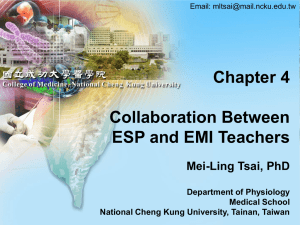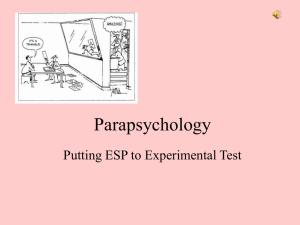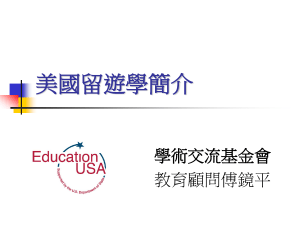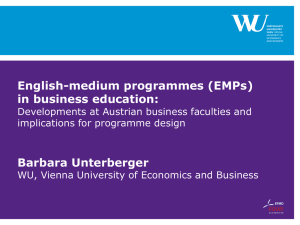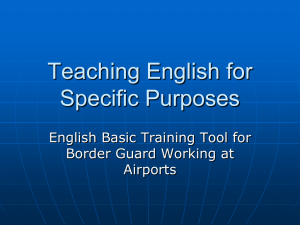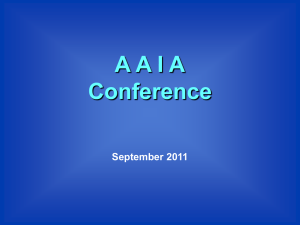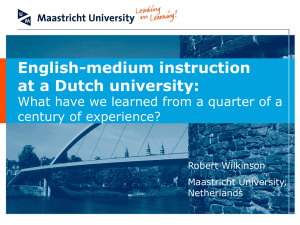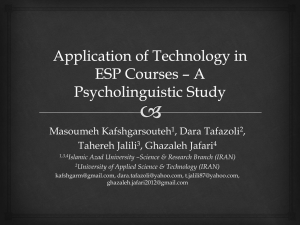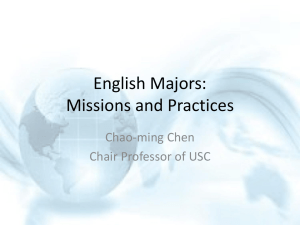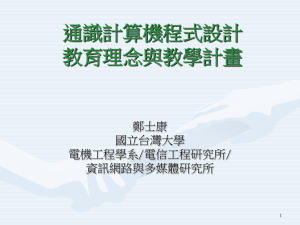writing
advertisement
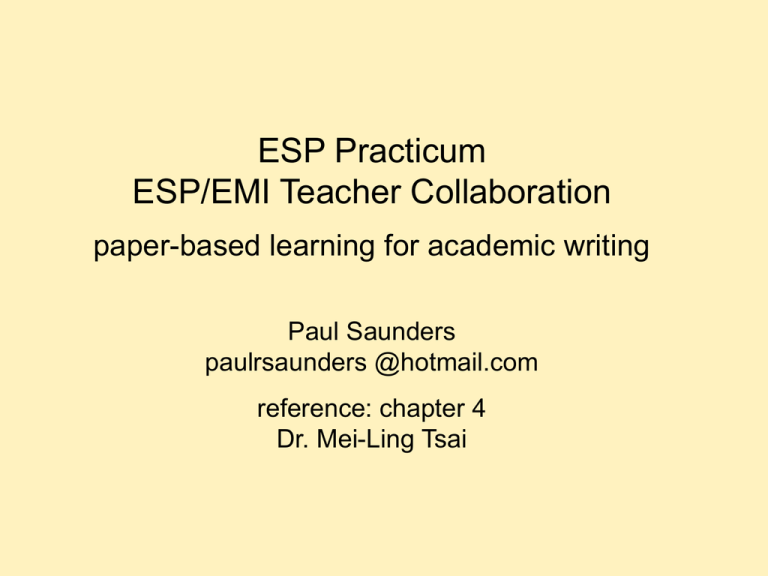
ESP Practicum ESP/EMI Teacher Collaboration paper-based learning for academic writing Paul Saunders paulrsaunders @hotmail.com reference: chapter 4 Dr. Mei-Ling Tsai Traditional Division of Instructional Responsibility Structure Content writing ESL Instructor ‘writing style’ Discipline Expert Language teaching how to write effectively must INTEGRATE expertises Structure Content Discipline Expertise writing WRITING EMI/ESP integration Critical Thinking ESL Expertise ‘writing style’ Language Three must-ask questions for team teachers in innovative ESP courses What to teach? Who to teach? How to teach? EMI teacher conversation ESP teacher Teacher Preparation work from strengths Structure Content writing WRITING Language Discipline Expertise EMI teacher ESL Expertise ‘writing style’ explain ESP teacher focus on General Content: Genre Analysis Scientific Academic Writing Author’s Objective: 1) Reader understands specific scientific project 2) Reader convinced the research is important Convince Project is: - novel - meaningful - valid Analyze research article general IMRD structure - use of structure & language - apply concepts in writing (Swales genre analysis of academic writing) Knowledge to Help Read Science (original article) Introduction’s Purpose (why do research) - Introduce topic of research (significance of field; general background information) - Cite HIGHLY relevant background research - Indicate a Need – the Unknown information (3 kinds) - extending previous findings - information gap - states that other research is wrong (questions theory) or other research requires some qualification - State purpose of study (take care of the Need – 3 ways) - state purpose, hypothesis OR specific research aims - introduce key method to accomplish purpose - state findings that resulted Novelty Knowledge to Help Read Science (original article) Methods’ Purpose (what was done) - describe experimental procedures (must be clear so others may repeat) Results’ Purpose (what was found) - describe outcomes of research project - some conclusion ok in describing and summarizing findings Validity Knowledge to Help Read Science (original article) Discussion’s Structure (typical segments) - State/Summarize KEY results Summarizing secondary results Use previous research to support findings Explain unexpected findings (explain contradictions with previous research) - Indicate study’s limitations - Provide conclusion, recommendations for future research and/or ‘benefits’ of study Meaningfulness Teacher Preparation work from strengths Structure Content writing WRITING Language Discipline Expertise EMI teacher ESL Expertise ‘writing style’ explain ESP teacher focus on appropriate Specific Discipline Content Teacher Preparation for ANY form of Communication (presentation & writing) Structure EMI teacher explain ESP teacher focus on effective organization of Specific Content Scientific Academic Communication Humans use ‘stories’ all the time - organize information - know how to behave - explain GENERAL phenomena (these are science stories) Data is NOT the story Story must explain (reader relevance) - future application for Reader (typically understanding) How to develop reader appropriate story? Storyboarding - organizes details: ALL events in story must be connected draw out research story use arrows (focus one at a time) to indicate events if describe in words “and” “then” good indicators of separate events Takes practice; Learning to think scientifically Research Story: Provides Content Framework Type 1: - Background Story (in gray) indicates the known info, so UNKNOWN info can be highlighted (put research purpose in context - rationale) - Research Story (in green) is what is new Initial stage Event 1 Event 2 Final Outcome - very typical to explain a new mechanism of action pathway in a biological system Teaching Duties (initial offering option) Time Process Wk 1 Analyze Model Paper - important concepts - general purpose of each major section (IMRD) Wk 2 Use Model Paper for example material - demonstrate how Central Theme is introduced - paragraph structure - section structure to develop an idea (genre analysis) Wk 3 Use Model Paper for example material - demonstrate how to present scientific article - demonstrate scientific storytelling Wk 4+ Students give presentation of an article they selected Teacher in charge EMI ESP ESP EMI&ESP evaluate Students prepare to write summary paragraph based on their selected article - examine how to select appropriate Central Theme for paragraph EMI - assess necessary details to support/explain Central Theme - demonstrate developing cohesion through linking phrases (language ESP examples from Model and Student-Selected articles) (continue with more writing skills & writing more sophisticated documents) for the STUDENTS Structure Content writing WRITING ESL Expertise ‘writing style’ Discipline Expertise EMI/ESP integration Critical Thinking Language Extra Story Framework types: - alter phenomena (ie. heal/prevent disease) - examine associations (relationship strengths) - multiple responses to condition Research Story: Provides Content Framework Type 2: - Background Story (in gray) indicates the known info, so UNKNOWN info can be highlighted (put research purpose in context - rationale) - Research Story (in green) is what is new Intervention 0 Event 1 Event 2 Event 3 Event 2’ Event 3’ - explain how a treatment intervention (eg. a drug) can change a system through an altered mechanism of action pathway in a system (typically biological) Research Story: Provides Content Framework Type 3: - Background Story (in gray) indicates the known info, so UNKNOWN info can be highlighted (put research purpose in context - rationale) - Research Story (in green & red) is what is new Factor A Factor B Initial stage Factor C Final Outcome Factor D - explain how particular factors are positively (green) and negatively (red) associated with a particular singular outcome – common in clinical sciences Research Story: Provides Content Framework Type 4: - Background Story (in gray) indicates the known info, so UNKNOWN info can be highlighted (put research purpose in context - rationale) - Research Story (in green) is what is new Outcome 1 Initial stage Factor C Outcome 2 Overall Condition Outcome 3 - a pattern of >1 outcome with each outcome measured independently; the outcomes are constituent elements of an overall condition - may include single factor that could alter outcomes
